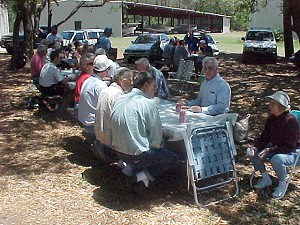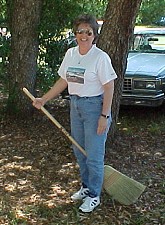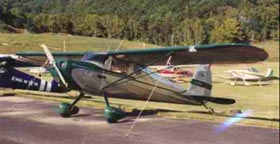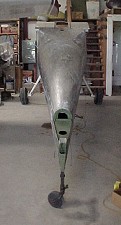 |
May 1999
EAA Chapter 108
|
 |
May 1999
EAA Chapter 108
|
| President, Robert Sutherland, 862-6191, sudsflyer@fwb.gulf.net
Vice President, Bob Brooks, 837-0531, bobbro@gnt.net Treasurer, Sandy Bowen, 862-7229 Secretary, Cliff Nunnery, 862-2673, joycen@cybertron.com |
Newsletter and Web Page Editor, John Jones, 682-3867,
jonesj@bsc.net
Technical Advisor, Bob Ray, 678-3133, banjobob@ix.netcom.com Flight Advisor, Monte G. McLean, 862-4832, montemac@cybertron.com Young Eagles Coordinator, Gerald Poltorak, 862-0652, aimhigh@bsc.net |
| Inside This Issue - May 1999 |
| Surprise Program
Pancake Breakfast Sun-n-Fun Ruckel Picnic |
30 Seconds to Impact!
Bob Ray's Collection Fly Market Summer Calendar |
| Chapter News
Announcements, new members, upcoming activities. |
 May
Meeting to Feature Surprise Presentation
May
Meeting to Feature Surprise Presentation
The next chapter meeting is scheduled for May 18, 1999. Plans for the presentation are still being finalized, but the program is sure to be a good one. The April meeting program was an excellent video of the early years of flying at Roosevelt Field on Long Island. The video featured Chapter 108's own Herb Ottewill explaining his adventures in the 1920's and 1930's.
Seventh Annual Otto Lilienthal Memorial Pancake Breakfast
Come join the Chapter for steaming hot pancakes and sizzling sausage on May 22, 1999 at the Crestview Airport. Drive or fly, but the food will be served around 9:00 a.m. Just follow your nose to the food in the Sunshine Aero hangar. Be sure to bring a friend and introduce them to EAA. For more information contact Bill Tuttle at 729-3967.
Miscellaneous
New Members
Chapter 108 gained a new member in March. Brian Kaczorowski is a Navy Ensign waiting to begin flight training at Pensacola Naval Air Station. Brian spent his honeymoon visiting various kit manufacturerers and has just begun building a Rans S-16 Shekari.
Wanna be a Webmaster?
If you've ever wanted to learn how a web page works, this is your big chance. John Jones is looking for a little help digitizing some old scrapbooks to add to the web page. All you need is a computer and a little time. Contact John Jones at 682-3867 or jonesj@bsc.net if you're interested.
Newsletter Subscriptions
If your address label doesn't have a "99" on it then you should pay your dues to continue receiving the newsletter. This will be the last newsletter for members that aren't paid up. Also, people with Internet access can receive the newsletter electronically if they prefer. Let John Jones know if you'd prefer an electronic copy instead of a paper copy.
Meeting Ideas
The Chapter leadership is looking for ideas for meeting programs. It is hoped that some programs on various aspects of aircraft construction can be scheduled later this year. Topics might include sheet metal, composites, electrical systems, wood, fabric, and welding. See Bob Sutherland with your ideas.
Treasurer's Report - In March, the chapter had an account balance of $835.28.
Logo Contest - The logo contest is inching closer to completion. The various submittals will be discussed at the next meeting if time allows.
Willing to Give Someone a Ride?
The chapter is looking for ways to match members and Young Eagles with
empty seats. One idea was to use the web page. Other ideas
might be an answering machine or a list posted somewhere. Bring your
ideas to the next meeting for discussion.
| Flying Fun
Chapter workshops, fly-ins, parties, and trip reports. |
Many members of the Chapter traveled south to the 25th annual spring gathering at Sun-n-Fun. Most folks remembered the week for being unusually hot and dusty. Things were so dry that a grass fire on Thursday caused the Ultralight area to be evacuated and the airshow to be cancelled.
On a brighter note, the show was host to many P-51 Mustangs that had attended the Gathering of Mustangs in Kissimmee, FL the week before Sun-n-Fun. Bruce Bohannon also showed up with his new Bohannan B-1, a hybrid RV-4 with RV-3, -6, and -8 parts, intended to break the record for maximum altitude in a piston-engine, propeller plane. A mechanic from Argentina, Marcelo Matocq, flew his ultralight almost 6000 miles, including a crossing of the Caribbean, to reach Lakeland. Look for Marcelo when he continues his flight to Oshkosh in July.
Several members recounted the landing crash of the twin and the Cessna 172. A few folks also mentioned the collision of the Lionheart prototype and an FAA truck. Your intrepid newsletter editor mostly recalls the cold driving rain of the last Saturday. Yuk! The funniest memory of Sun-n-Fun was of a beer-drinking pig that Mike Marra saw at a fuel stop on the way down. Mike says the pig was worth the stop. Remember that when planning for next year!
On May 1, the Chapter kicked off the month with a picnic at Ruckel Airport
in Niceville, FL. The weather was absolutely gorgeous and approximately
50 folks made the trip with at least five planes flying in. As usual,
Dick, Cliff, and Richard manned the grills and served up outstanding burgers.
Other food was pot-luck with more available than could be eaten.
One highlight of the event was Pat Morrison's new flying craft: her
broom complete with N-number!


Mother's Day Trip to Point Clear, Alabama
Four Chapter members traveled to the Grand Hotel at Point Clear, Alabama
on May 8, 1999. They enjoyed an outstanding buffet and spend several
hours strolling the grounds. They report that the hotel's cemetery
was particularly interesting. The hotel was used as a hospital during
the Civil War and soldiers that died in the hospital were buried nearby.
Many of the soldiers could not be identified and are buried in a special
section of the cemetery. Persons visitng the hotel can ask the airport
unicom to call the hotel and request transportation. A ride should
be waiting when the visitors land.
| Hangar Flying
Aviation jokes, tall tales, and other humor. |
| Shiny Side Up
Important safety or regulatory issues |
The morning of January 18, 1993 was typical of the beautiful North Florida weather so common for that time of year. As my friend and I mounted up my trusty 140 for a short flight to a nearby airport where I had my hangar, little did we know this would be a day that would forever be engraved in our memory.
I had flown the little bird a couple of hours the day before, so the preflight was uneventful with no surprises. She cranked without complaint, and after a good runup and final "fuel, flaps, trim, controls" check, we were ready to roll. Since I am a CFI, I took the right seat in order to give my friend some recurrency in taildraggers and generally just some fun flying. A check of the pattern and we were rolling. The 0-200 showed a good solid 2450 RPM on the roll and the oil pressure was steady at 45 psi. My friend did a textbook takeoff and settled into a climb at 80 mph.
I had relaxed and was looking forward to an easy flight when I sensed a barely discernible drop in RPM. Assuming it was throttle creep I reached over and checked the throttle friction and pushed the throttle to regain the lost RPM. The throttle was already full open but by now the RPM was passing 2000. I told my friend, "I have the airplane" and started doing the normal things that training and experience dictate as the RPM continued to decay to windmill speed. It seemed as if something was trying to choke the engine to death. Pull carb heat, switch tanks, pick up glide speed, look for landing sites, pump throttle in hopes the accelerator pump might just provide help - no response! My eyes went from the airspeed indicator which read 70 mph to the altimeter which read 250 feet.
When I give biennial flight reviews I have made it a practice to have the pilot demonstrate how much altitude his airplane will lose in a 210 degree turn at best glide speed in case he ever had need to do an emergency turn back to the field he had just departed. The words of my first instructor, over 40 years ago, ran through my mind saying, "Son, if the motor quits on takeoff, go straight ahead, the graveyards are full of folks who tried to turn around and didn't make it." I knew without question that my 140 loses from 450 to 500 feet during that maneuver, so turning back was not an option anyway.
I will say, however, that the urge to turn back was the strongest I can ever remember in all my flying experience. I distinctly remember thinking, "Maybe I can do a near hammerhead turn and get around, but then I have my passenger to consider.
Thankfully, my better judgment prevailed and I told my friend, "Cinch up your harness, I think we're going to have to put it in the trees." I had installed shoulder harnesses in the little bird two years prior to this flight, and how glad I was that I had the foresight to do so. There was nothing but trees ahead, that I could see, so I planned to land on the treetops as if they were a runway and accept the consequences.
As the trees loomed below us almost close enough to touch, a 300-foot cul-de-sac miraculously appeared out of nowhere amidst the houses hidden in the trees. Although it was almost 90 degrees to our flight path and we were over the end, I put in full left rudder and right aileron in an attempt to slip into the corridor of trees. I was almost lined up when I decided to force it onto the pavement and try to go between two trees at the end. We hit the ground with a tremendous force that caused the landing gear to fold rearward, and nose to impact very hard with the pavement. The wings wedged between the two trees, each one about three to four feet out from the cockpit.
In my mind, we both survived as a direct result of the shoulder harness. My friend crawled from the wreckage by himself, with a severe bump and cut on his forehead, however I had to be pulled out by a couple of folks who witnessed the accident, one of whom was a doctor who conveniently lived in an adjacent house. I also had a severely cut forehead and was unconscious for about two to three minutes. I have yet to determine what our heads hit, but the best I could guess was that both our heads were jerked sideways into the door post by the force of sudden impact. There were no marks on the instrument panel to show impact. My most painful injury was from fuel dripping from a ruptured wing tank onto my clothes. My back was severely blistered and it took a couple of weeks for that to heal.
The aftermath was probably similar to the accidents many of you have experienced or observed. The NTSB did their accident investigation and found nothing wrong with the airplane and my credentials were all in proper order. They reviewed my logs, pilot certificate, medical certificate, and biennial review date. I was very interested to find some cause for the engine failure so I gave my fullest support to all efforts.
The engine was taken to Teledyne Continental Motors in Mobile, AL. They installed a new oil sump because the old one was distorted, but the other engine parts were usable. They put the engine on a test stand and it cranked almost immediately. It operated at speeds up to 2700 RPM with no problems apparent. The carburetor was disassembled and inspected and found to be free of defects. The float level was correct and no evidence of water, either past or present, was detected. There was still no evidence as to what caused my problem.
I have experienced carburetor icing on a number of occasions while flying, but always at cruise speed and altitude, and when I had had time to pull carb heat and have it become effective (which, by my actual test, takes from 45 seconds to 1 minute-30 seconds to return systems to normal). In this case, on takeoff, carb ice was not high on my "suspected causes" list. But to be sure I covered all possibilities, I contacted the local Air Force weather station and asked for the temperature and humidity at my location at the exact time of my accident, they were very cooperative and checked their logs for that date. At 0830 on Jan 18, the humidity at my location was 82% and the temperature was 52 degrees. In checking the NTSB chart of potential icing conditions, I found that these two figures fall right in the middle of the worst possible conditions for carburetor ice.
My skepticism about the possibility of carb ice evaporated with his hard evidence. The engine performance definitely resembled my former experiences with carb icing, but my engineering background had made me doubtful. To this day I have not arrived at any better explanation than that I experienced Carburetor icing on takeoff and the resulting engine failure was the direct result.
One thing I learned that is unquestionable; at a rate of descent of 450 feet per minute at 70 mph in a Cessna 140 from an altitude of 250 feet above the terrain, you have approximately 30 seconds to think about a multitude of things, and one of them should NOT have to be, "What am I going to do?" If you haven't considered it, thought about it, practiced it, or prepared for it, don't expect it to miraculously appear in that critical 30 seconds when your heart rate is at redline, and the pucker factor off the charts. Most of the things you do will be from instinct resulting from prior training and experiences.
I have been flying for 43 years and over 6000 flying hours (1500 in the Cessna 140), and I'm thankful I never subscribed to the theory, *It can never happen to me." It did happen, and I survived because I did what I had been trained to do, and had taken the time to prepare my airplane and myself for just such an unscheduled event. I'm living today, and I can say, "Been there, done that, have head scar to prove it.
| Builder’s Log
Building hints and various aircraft projects from Chapter 108. |
Most aviation enthusiasts have only one plane; if they are lucky they may have two. Bob Ray has seven. Well, he has enough parts and pieces to assemble seven aircraft. You see, Bob's got a hangar at Yellow River Airport full of aircraft in various stages of repair (or disrepair) that he spends his days working on.
Most chapter members know that Bob is the Technical Counselor for Chapter 108 and that he normally files a beautiful silver and green Cessna 140. What some folks may not know is that Bob is a retired Air Force colonel who's been working on planes for years. Bob's Air Force career started as a back-seater flying F-94's in Korea. Bob then flew the F-89, F-101B, and F-4. After flying F-105's in Viet Nam, Bob became the Director of Maintenance with the U-2 program at Edwards AFB. Most of the remainder of Bob's career was spent in various maintenance roles with his final assignment being Eglin AFB. Bob got his A&P certificate in 1970 so that he could do his own maintenance on a Taylorcraft that he owned. He later received his Inspection Authorization in 1978.
A few years ago Bob bought a 1946 Taylorcraft BC-12D that he restored and that has been featured on the cover af the Taylorcraft Association calendar. The engine was upgraded from a C-65 to a C-85 variant that produces about 90 hp. According to Bob, it's a real rocket ship (for a Taylorcraft). The aircraft has a beautiful white paint job with a red stripe down the side. Bob's son has said that this T'craft is one of his two favorite planes; the other is an F-16.
Bob is best known for his many Cessna 140s. The silver and green
140 that Bob often flies is rather unusual. Although most 140s came
with a fabric covered wing, Bob's 140 has an aluminum wing skinned completely
with flush rivets. The craftsmanship of the wing is a true work of
art. As a matter of fact, the flush rivets were the thing that attracted
Bob to that particular plane. Bob had performed maintenance on the
plane for the previous owner and when Bob crashed his own 140 in 1993,
the plane's owner offered to sell. The first thing Bob did was restore
the panel to it's factory-new appearance with original instruments.
He later upgraded the C-85 engine to an O-200. The plane really is
beautiful. Take a good look at it at the next fly-in.



Bob's current project is a Luscombe that's undergoing restoration.
The plane suffered a hard landing years ago and the gear was bent.
Bob flew the plane from 1993 until he had a fuel line problem in 1995.
At that point he decided to tear down the plane and do a proper restoration.
The entire floorboard and gear were removed and rebuilt. The plane
now sits level and Bob estimates that the plane should be ready in about
six months if he's lucky.


Also in Bob's hangar are an assortment of other projects. There's a Cessna 182 that Bob restored and has kept as a "traveling" plane. The 182 is currently getting a panel upgrade. There's the Cessna 140 that's completely disassembled and stacked against the wall. There's the 1941 Taylorcraft BL-65 that was in a crash. There's the collection of Cessna 140 parts that Bob may someday use to create another 140. There are several spare engines sitting around the hangar too.
If you want to see how airplane restoration is really done or if you just want to look at some beautiful old airplanes, drop by and visit Bob. He's at his hangar most days and would love the company.
Correction from April: The water ballast found on Bill Reeder's SZD-52 Krokus is not used to trim the plane. The extra weight is added to increase the speed at which the best lift/drag ratio is achieved.
| Fly Market
Contact John Jones to place an ad. |
The following items are for sale by Jack Harvey (850) 892-2862.
All items always hangared with 58 hours Total Time.
| Altimeter $120
Rate of Climb $85 Turn Indicator $245 Whiskey Compass $75 Hobbs $45 |
Tach (sm) $50
Cylinder Head Temp (sm) $35 Vacuum Pump $265 Revmaster 65 HP 4cyl. engine, 58 hr TT $1495. |
| Calendar |
June 15, 1999 - Monthly Chapter Meeting
June 19, 1999 - Picnic or Camping Trip
July 17, 1999 - Ice Cream Fly-in, Sikes Airport, Crestview,
FL
July 20, 1999 - Monthly Chapter Meeting
July 28 - August 3, 1999 - EAA
Airventure Oshkosh